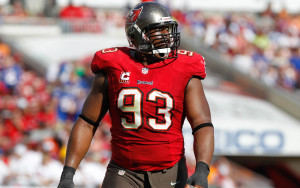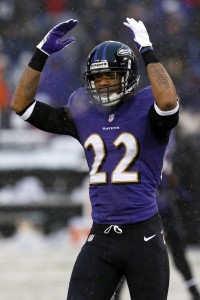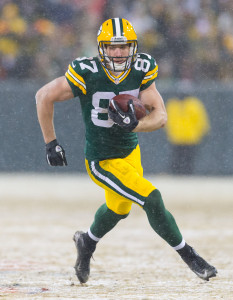Yesterday, we took a closer look at the players with the largest cap hits for 2014 on the offensive side of the ball. Today, we’ll shift our focus to defense, as well as examining punters and kickers. These guys aren’t necessarily taking in the largest cash payments for the 2014 season, but a combination of base salary and bonuses ensure that their cap numbers are among the NFL’s highest.
As was the case with the offensive players, even just a quick glance at the lists below reveal details about how certain clubs have constructed their rosters, and hint at salary trends by position. Before we jump into the top 2014 cap hits on defense and special teams by position, a few observations about the players that show up on these lists:
- There are a few instances on the offensive side of the ball where positional lines are blurred — a running back like Darren Sproles often acts as a de facto wide receiver, as do tight ends like Jimmy Graham. But those lines are blurrier on defense, where some teams run 3-4 defenses and others run 4-3. Defensive ends generally get more opportunities to rush the quarterback in 4-3 defenses, so it’s no surprise that four of the top five DEs on this list play in 4-3 systems. Only Haloti Ngata is the exception.
- Similarly, 3-4 outside linebackers are their teams’ primary pass rushers, and all five of the top OLB cap hits belong to 3-4 players.
- The current highest cap hit for an outside linebacker actually belongs to LaMarr Woodley of the Steelers. Pittsburgh released him earlier in the offseason, but designated him as a post-June 1 cut, so for now he continues to count for $13.59MM against the team’s cap. That will change in a matter of days though, when Woodley’s 2014 cap number is reduced to just $5.5MM, so we left him off this list.
- Still, had Woodley been included, it would have only further illustrated the Steelers‘ dedication to stockpiling impact linebackers. Even without Woodley, Pittsburgh still has a top-five cap hit at OLB in Jason Worilds, and the No. 1 cap hit at ILB in Lawrence Timmons. Linebacker may not have been a position of need when the Steelers drafted Ryan Shazier in the first round earlier this month, but it’s hardly a shock that the club went in that direction.
- The only team with two players on the same list below? The Panthers, with a pair of defensive ends accounting for nearly $30MM in cap space. No wonder the club didn’t have much room left over to add an impact receiver.
- Joe Haden‘s cap number has yet to be confirmed, since he recently inked an extension, and Over the Cap and Spotrac had different figures for the cornerback. So the number here is an estimation. Either way though, he appears likely to rank second overall this season.
- The Broncos have the league’s reigning MVP in Peyton Manning and spent big on defense this offseason, but that doesn’t mean they’re ignoring special teams at all. Denver is the only club with both a kicker and punter among the top five cap hits.
Here are the lists of the top five 2014 cap hits by defensive and special teams position:
Defensive end:
- Mario Williams, Bills: $18.8MM
- Charles Johnson, Panthers: $16.42MM
- Haloti Ngata, Ravens: $16MM
- Chris Long, Rams: $14.9MM
- Greg Hardy, Panthers: $13.116MM
Defensive tackle:
- Ndamukong Suh, Lions: $22.413MM
- Gerald McCoy, Buccaneers: $15.627MM
- Geno Atkins, Bengals: $9MM
- Ahtyba Rubin, Browns: $8.175MM
- Barry Cofield, Redskins: $7.678MM
Outside linebacker:
- Tamba Hali, Chiefs: $11.465MM
- Brian Orakpo, Redskins: $11.455MM
- Clay Matthews, Packers: $10.944MM
- Jason Worilds, Steelers: $9.754MM
- Robert Mathis, Colts: $8.75MM
Inside linebacker:
- Lawrence Timmons, Steelers: $11.816MM
- James Laurinaitis, Rams: $10.4MM
- Paul Posluszny, Jaguars: $9.5MM
- Dannell Ellerbe, Dolphins: $7.425MM
- David Harris, Jets: $7MM
Cornerback:
- Brandon Carr, Cowboys: $12.217MM
- Joe Haden, Browns: $11.728MM
- Johnathan Joseph, Texans: $11.25MM
- Brandon Flowers, Chiefs: $10.5MM
- Lardarius Webb, Ravens: $10.5MM
Safety:
- Eric Berry, Chiefs: $11.62MM
- Eric Weddle, Chargers: $10.1MM
- Antrel Rolle, Giants: $9.25MM
- Dashon Goldson, Buccaneers: $9MM
- Michael Griffin, Titans: $8MM
Kicker:
- Josh Scobee, Jaguars: $4.188MM
- Matt Prater, Broncos: $3.813MM
- Stephen Gostkowski, Patriots: $3.8MM
- Nick Folk, Jets: $3.6MM
- Mason Crosby, Packers: $3.4MM
Punter:
- Mike Scifres, Chargers: $4.035MM
- Dustin Colquitt, Chiefs: $3.8MM
- Brandon Fields, Dolphins: $3.586MM
- Michael Koenen, Buccaneers: $3.25MM
- Britton Colquitt, Broncos: $3.25MM
Contract information from Over The Cap was used in the creation of this post.


